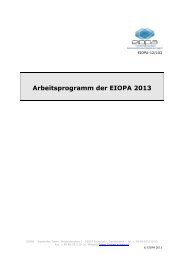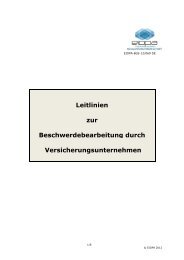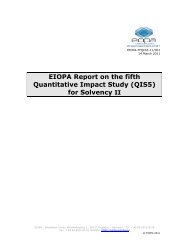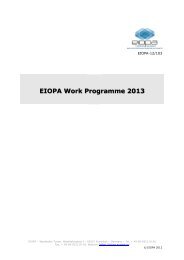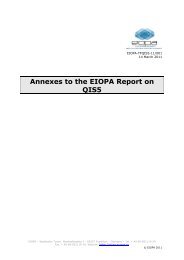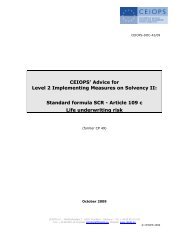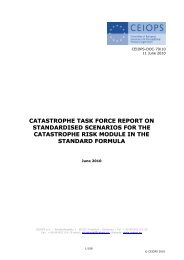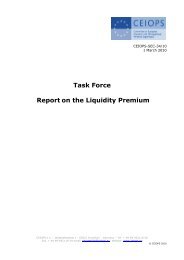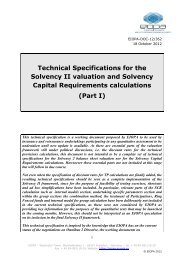Answers to the European Commission on the ... - Eiopa - Europa
Answers to the European Commission on the ... - Eiopa - Europa
Answers to the European Commission on the ... - Eiopa - Europa
Create successful ePaper yourself
Turn your PDF publications into a flip-book with our unique Google optimized e-Paper software.
additi<strong>on</strong> a range of stresses so that even in stressed circumstances 69<br />
this applied. While <str<strong>on</strong>g>the</str<strong>on</strong>g> SCR could, in principle, capture this, it might be<br />
that an internal model that met CEIOPS criteri<strong>on</strong> failed <str<strong>on</strong>g>to</str<strong>on</strong>g> do so,<br />
because <str<strong>on</strong>g>the</str<strong>on</strong>g> probability of failure of <str<strong>on</strong>g>the</str<strong>on</strong>g> counterparty was c<strong>on</strong>sidered<br />
very improbable.<br />
9.92 By exposure CEIOPS means <str<strong>on</strong>g>the</str<strong>on</strong>g> amount by which capital would fall if<br />
<str<strong>on</strong>g>the</str<strong>on</strong>g> counterparty is unwilling or unable <str<strong>on</strong>g>to</str<strong>on</strong>g> meet any part of its liabilities.<br />
Thus all c<strong>on</strong>tracts with it would become worthless, except <str<strong>on</strong>g>to</str<strong>on</strong>g> <str<strong>on</strong>g>the</str<strong>on</strong>g> extent<br />
that <str<strong>on</strong>g>the</str<strong>on</strong>g>y were guaranteed by a third party independent of <str<strong>on</strong>g>the</str<strong>on</strong>g><br />
counterparty, covered by collateral (deposited or mortgaged assets<br />
that <str<strong>on</strong>g>the</str<strong>on</strong>g> insurer could use <str<strong>on</strong>g>to</str<strong>on</strong>g> meet <str<strong>on</strong>g>the</str<strong>on</strong>g> liabilities), covered by a<br />
enforceable right of offset (which enables <str<strong>on</strong>g>the</str<strong>on</strong>g> insurer <str<strong>on</strong>g>to</str<strong>on</strong>g> reduce a<br />
liability <str<strong>on</strong>g>to</str<strong>on</strong>g> <str<strong>on</strong>g>the</str<strong>on</strong>g> counterparty if it fails <str<strong>on</strong>g>to</str<strong>on</strong>g> meet liabilities <str<strong>on</strong>g>to</str<strong>on</strong>g> <str<strong>on</strong>g>the</str<strong>on</strong>g> insurer).<br />
In principle, <str<strong>on</strong>g>the</str<strong>on</strong>g> effect of <str<strong>on</strong>g>the</str<strong>on</strong>g> counterparty's insolvency <strong>on</strong> investments<br />
in third parties should be taken in<str<strong>on</strong>g>to</str<strong>on</strong>g> account. This definiti<strong>on</strong> is intended<br />
<str<strong>on</strong>g>to</str<strong>on</strong>g> take in<str<strong>on</strong>g>to</str<strong>on</strong>g> account <str<strong>on</strong>g>the</str<strong>on</strong>g> effect of any mitigants and of any indirect<br />
exposures. Some technicalities of this proposal would need fur<str<strong>on</strong>g>the</str<strong>on</strong>g>r<br />
analysis.<br />
9.93 Some excepti<strong>on</strong>s <str<strong>on</strong>g>to</str<strong>on</strong>g> such a limit would be worth c<strong>on</strong>sidering. The<br />
following are discussed below:<br />
• exposure <str<strong>on</strong>g>to</str<strong>on</strong>g> subsidiaries;<br />
• government b<strong>on</strong>ds, and o<str<strong>on</strong>g>the</str<strong>on</strong>g>r loans <str<strong>on</strong>g>to</str<strong>on</strong>g> governments or<br />
guaranteed by <str<strong>on</strong>g>the</str<strong>on</strong>g>m;<br />
• short term bank deposits; and<br />
• reinsurance (because it might be impractical <str<strong>on</strong>g>to</str<strong>on</strong>g> impose this<br />
restricti<strong>on</strong> <strong>on</strong> reinsurance).<br />
9.94 Subsidiaries can be valued by looking through <str<strong>on</strong>g>to</str<strong>on</strong>g> <str<strong>on</strong>g>the</str<strong>on</strong>g>ir assets and<br />
liabilities and c<strong>on</strong>solidating. 70 The subsidiary’s assets and liabilities can<br />
<str<strong>on</strong>g>the</str<strong>on</strong>g>n be reflected in <str<strong>on</strong>g>the</str<strong>on</strong>g> calculati<strong>on</strong> of <str<strong>on</strong>g>the</str<strong>on</strong>g> parent’s SCR. If this is d<strong>on</strong>e<br />
and indirect exposure <str<strong>on</strong>g>to</str<strong>on</strong>g> third parties (including o<str<strong>on</strong>g>the</str<strong>on</strong>g>r group<br />
companies) through <str<strong>on</strong>g>the</str<strong>on</strong>g> subsidiary are fully taken in<str<strong>on</strong>g>to</str<strong>on</strong>g> account, <str<strong>on</strong>g>the</str<strong>on</strong>g>n<br />
direct exposure <str<strong>on</strong>g>to</str<strong>on</strong>g> <str<strong>on</strong>g>the</str<strong>on</strong>g> subsidiary could be excluded from <str<strong>on</strong>g>the</str<strong>on</strong>g> rule. This<br />
exclusi<strong>on</strong> would not apply <str<strong>on</strong>g>to</str<strong>on</strong>g> o<str<strong>on</strong>g>the</str<strong>on</strong>g>r group companies (i.e. parents and<br />
fellow subsidiaries). The aggregate exposure <str<strong>on</strong>g>to</str<strong>on</strong>g> <str<strong>on</strong>g>the</str<strong>on</strong>g> group (o<str<strong>on</strong>g>the</str<strong>on</strong>g>r than<br />
<str<strong>on</strong>g>to</str<strong>on</strong>g> subsidiaries) should be taken in<str<strong>on</strong>g>to</str<strong>on</strong>g> account, <str<strong>on</strong>g>to</str<strong>on</strong>g>ge<str<strong>on</strong>g>the</str<strong>on</strong>g>r with indirect<br />
exposures <str<strong>on</strong>g>to</str<strong>on</strong>g> subsidiaries.<br />
9.95 However, <str<strong>on</strong>g>the</str<strong>on</strong>g> practicalities of this approach need <str<strong>on</strong>g>to</str<strong>on</strong>g> be assessed (e.g.<br />
when <str<strong>on</strong>g>the</str<strong>on</strong>g> insurer is not required <str<strong>on</strong>g>to</str<strong>on</strong>g> c<strong>on</strong>solidate <str<strong>on</strong>g>the</str<strong>on</strong>g>ir subsidiaries). In<br />
particular, it might be argued that this excepti<strong>on</strong> should not apply when<br />
<str<strong>on</strong>g>the</str<strong>on</strong>g> subsidiary bears insurance risk.<br />
69 For instance if interest rates fell, <str<strong>on</strong>g>the</str<strong>on</strong>g> value of b<strong>on</strong>ds would rise. If assets and liabilities were broadly<br />
matched, <str<strong>on</strong>g>the</str<strong>on</strong>g> capital might not change significantly, but a b<strong>on</strong>d that was 90% of capital might represent<br />
110% of capital. It would be unfortunate if <str<strong>on</strong>g>the</str<strong>on</strong>g> fall in interest rates led <str<strong>on</strong>g>to</str<strong>on</strong>g> <str<strong>on</strong>g>the</str<strong>on</strong>g> insolvency of <str<strong>on</strong>g>the</str<strong>on</strong>g> issuer.<br />
70 See also answer <str<strong>on</strong>g>to</str<strong>on</strong>g> CfA 18.<br />
67



